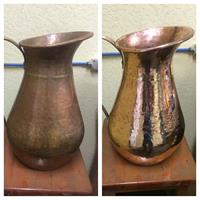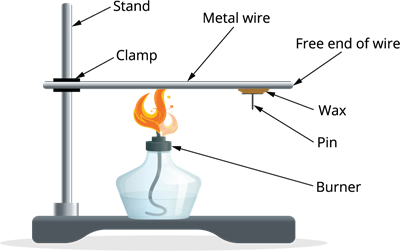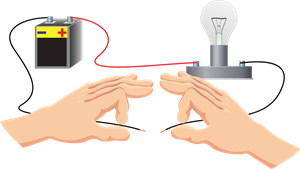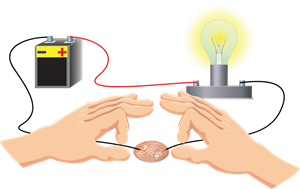
PUMPA - SMART LEARNING
எங்கள் ஆசிரியர்களுடன் 1-ஆன்-1 ஆலோசனை நேரத்தைப் பெறுங்கள். டாப்பர் ஆவதற்கு நாங்கள் பயிற்சி அளிப்போம்
Book Free DemoA property of a substance that can be observed without changing the substance's composition is called physical property.
The following are the physical properties of metal:
- Physical state
- Lustre
- Hardness
- Density
- Melting and boiling point
- Malleability
- Ductility
- Conductivity
- Sonorous
Let us look at them in detail.
Physical state
Metals are usually found solid at NTP (Normal Temperature and Pressure). However, mercury is liquid at room temperature. Cesium (\(Cs\)), rubidium (\(Rb\)), francium (\(Fr\)) and gallium (\(Ga\)) become liquid at or just above room temperature.
Lustre
Metals have a shining surface in their purest form. This property is known as 'metallic lustre'. Metallic lustre means reflected light resembles a polished metal surface.
Activity 1:
- Take iron, copper, aluminium and magnesium samples. Take note of how each sample appears.
Answer: They have a shining surface.
- Using sandpaper, clean the surface of each sample and take note of its look once again.
Answer: They become more shiny.

The appearance of copper: Before and after cleaning with sandpaper.
Image credits: link
Metals are generally hard. The hardness varies from metal to metal.
Take small pieces of iron, copper, aluminium or magnesium. Try to cut these metals with a sharp knife. You cannot cut it. On the other hand, alkali metals (lithium, sodium, potassium) are soft enough to be cut by a knife.
Activity 2:
- Take tiny pieces of iron, copper, aluminium and magnesium. Try cutting these metals with a sharp knife and take notes.
Answer: They are very difficult to cut.
- Using tongs, hold a piece of sodium metal.
CAUTION: Always handle sodium metal with care.
- Press it between the folds of a filter paper to dry. Try to cut it with a knife by putting it on a watch-glass. What do you notice?
Answer: Sodium is easily sliced with a knife.
Density
The density of a substance is defined as its mass per unit volume.
Metals have a high density except for alkali metals (lithium, sodium, potassium), which have low densities.
Melting and boiling point
The melting point of a substance is the temperature at which it changes from a solid to a liquid.
The boiling point is the temperature at which a liquid transforms into a gas or vapour at normal atmospheric pressure.
Except for alkali metals (lithium, sodium, potassium), mercury, caesium and gallium, metals have high melting points. Gallium and caesium will melt if you keep them on your palm.
Malleability
Malleability is the material's ability to be hammered or forced permanently out of shape without breaking or cracking, known as malleability.
Some metals have the ability to be beaten into thin sheets. This property is known as malleability. The most malleable metals are silver and gold.
Ductility
The property of metals that allows them to be pulled into thin wires is called ductility. Gold is the most ductile metal.
Activity 3:
Consider the metals iron, copper, aluminium, lead and so on. Which of the metals listed above are also available as wires?
Answer: Iron, copper and aluminium.
Did you know?
One gram of gold may produce a wire with a length of around \(2\) kilometres. Metals may be molded into various shapes depending on our needs due to their malleability and ductility.
Conductivity
The ability of a material to conduct heat or electricity.
Heat conductivity:
Metals are good conductors of heat.
Activity 4: To find metals are good conductors of heat.
- Take a wire made of aluminium or copper.
- Clamp this wire on a stand. Using wax, attach a pin to the free end of the wire.
- Heat the wire near the clamping point with a spirit lamp, candle or burner.
- What do you notice when some time has passed?

Testing a metal wire to see if it is a good conductor of heat.
Answer: Since the wire has not melted, it proves that metal is a good conductor of heat and has a high melting point.
Silver and copper are the best conductors of heat, while lead and mercury are relatively poor heat conductors.
Electrical conductivity:
1. Make a circuit by using a battery, bulb and copper wires, as shown below.

2. Place a copper coin between the two free ends of the wire in the circuit, as shown below.

3. The bulb is glowing because metals are good conductors of electricity.
As metals contain free electrons, they are good conductors of electricity. These free electrons move easily through the metal and conduct electric current.
You have probably noticed that the wires that carry current in your homes have a coating of a rubber-like material called polyvinylchloride (PVC).
Why are electric wires coated with PVC?

Electric wires coated with PVC
PVC is used to coat electric wires and cables to prevent electric shock since it is an insulator and a bad conductor of electricity.
Sonorous
Sonorous metals are those that make a sound when they strike a hard surface.
Example: School bell
Reference:
https://1.bp.blogspot.com/-kpCdiNTyXf4/WMbnYWVLboI/AAAAAAAARQk/ih7_pQFGR-ckJDjRtkXVyVlbSx6Pv0jwgCLcB/s1600/CONDUCTINGINSULATINGWIRE.png
https://static.scientificamerican.com/sciam/cache/file/3C2E23FD-92A9-445C-B6277C77F4778B19_source.jpg?w=590&h=800&C44FB252-DC48-4E4C-BB7BF2A533AC63E1
https://02f0a56ef46d93f03c90-22ac5f107621879d5667e0d7ed595bdb.ssl.cf2.rackcdn.com/sites/5337/photos/231211/IMG_0896120160926-16535-1y7n49q_original.jpg
https://hi-static.z-dn.net/files/dfa/018fbfde06e00a73ac0a1cf719826930.jpg